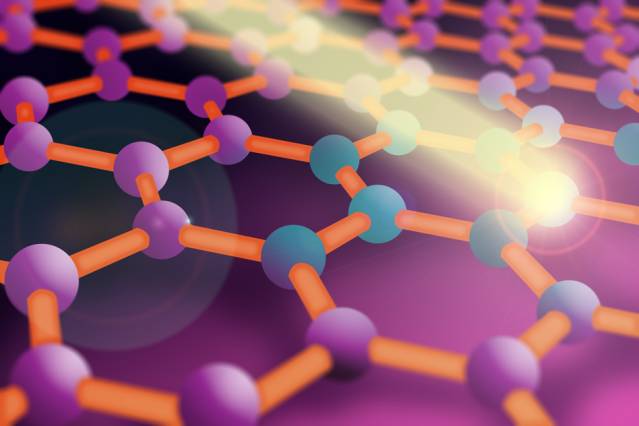Light pulses control how graphene conducts electricity
August 4, 2014

Researchers at MIT have found a way to control how graphene conducts electricity by using extremely short light pulses. In this illustration, a lattice of graphene is shown with its bonds (bars) connecting carbon atoms (balls). When the light pulse hits the atoms, electrons can accumulate or diminish in number. By controlling the concentration of electrons in a graphene sheet, researchers can change the material’s electrical conductivity. (Credit: Jose-Luis Olivares/MIT)
MIT researchers have found a way to control how graphene conducts electricity — using an extremely short but intense light pulse, which could enable graphene’s use as a broadband light detector.
By controlling the concentration of electrons in a graphene sheet, they could change the way the material responds to the light pulse:
- At low electron concentration, the pulse increases the material’s electrical conductivity (this is how traditional semiconductors, such as silicon and germanium, behave).
- At high electron concentration, the pulse decreases its conductivity — the same way a metal usually behaves.
The researchers say the work could help in developing new light detectors with ultrafast response times and high sensitivity across a wide range of light frequencies, from the infrared to ultraviolet.
However, the actual percentage of light absorbed is small, so practical applications would require increasing absorption efficiency, such as by using multiple layers of graphene, the researchers say.
The new findings are published in the journal Physical Review Letters. The work received support from the U.S. Department of Energy and the National Science Foundation.
Oops factor
In other graphene news, University of Notre Dame scientists have found that UV light initiates an oxidation process that breaks up a water-dispersible form of graphene — eventually decomposing it to CO2 and water (or even toxic compounds in some cases), Chemical & Engineering News reports. Ironically, the same process could potentially be used for environmental remediation of related carbon contaminants, including carbon nanotubes, fullerenes, and other nanostructured forms of carbon, the journal notes.
* The team deposited graphene on top of an insulating layer with a thin metallic film beneath it; by applying a voltage between graphene and the bottom electrode, the electron concentration of graphene could be tuned. The researchers then illuminated graphene with a strong light pulse and measured the change of electrical conduction by assessing the transmission of a second, low-frequency (near-infrared) light pulse. (The short light pulses also allow the researchers to change and reveal graphene’s electrical response in only a trillionth of a second.)
Abstract of Physical Review Letters paper
We investigate the transient photoconductivity of graphene at various gate-tuned carrier densities by optical-pump terahertz-probe spectroscopy. We demonstrate that graphene exhibits semiconducting positive photoconductivity near zero carrier density, which crosses over to metallic negative photoconductivity at high carrier density. These observations can be accounted for by the interplay between photoinduced changes of both the Drude weight and carrier scattering rate. Our findings provide a complete picture to explain the opposite photoconductivity behavior reported in (undoped) graphene grown epitaxially and (doped) graphene grown by chemical vapor deposition. Notably, we observe nonmonotonic fluence dependence of the photoconductivity at low carrier density. This behavior reveals the nonmonotonic temperature dependence of the Drude weight in graphene, a unique property of two-dimensional massless Dirac fermions.